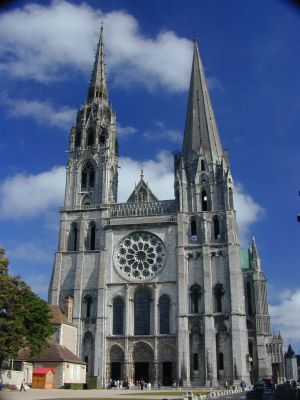
The
Mysteries of
by
Sir Ronald Fraser

What
I have to say derives from a book by M. Louis Charpentier called Les Mystéres
de la Cathédrale de
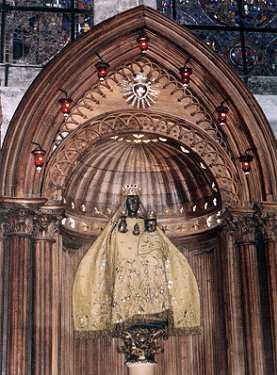
The Black Virgin
M.
Charpentier maintains that the Gothic mode, which came into being suddenly, was
purposeful. Who taught the builders how to balance weight and counterweight, to
arrange masses of stone so that the building vibrates to the tap of a
fingernail? How to make glass that might have come from an alchemist's crucible?
Who communicated the secret of ogive and pointed arch, and to whom? Nobody
knows. Our author suggests that the Gothic mode expressed a principle the gods
wished to make effective - a procedure that corresponds with the manifestation
of a higher will that was regular in
The
men who built
The
cathedral stands on an eminence, a mound not unlike a tumulus. In Christian
times it was one of the most sought-after places of pilgrimage in
Those
who took the pilgrim's staff set out, not knowing if they would see home and
family again, and faced the most formidable difficulties and dangers in order to
reach a place where divinity dwelt. They sought a gift, one that Earth bestows
like a mother; a place where a man breathes in spirit, steeps himself in it,
that it may quicken the consciousness of itself in his being. A place, too,
where quickening is brought about by terrestrial action.
An
old Gaulish name, Wouivre, is given to snakes that glide, to rivers that snake
through the landscape, to telluric currents that snake underground from the
depths of the terrestrial strata, bringing life that fructifies Earth and
Again,
the crypt or grotto beneath the cathedral is a dolmenic chamber. A dolmen is
found at a spot where the telluric current exercises its action. It is a stone
table, resting on supports, that acts like an accumulator and it is capable of
vibration, so that it acts as an amplifier as well; it is a drum. Thus, it is in
the domenic chamber that man seeks Earth's gift. It seems probable that the
cathedral stands over a point where a particular current surfaces, a current
that may awaken a man to the spiritual life in him.
That
is why among all the churches in
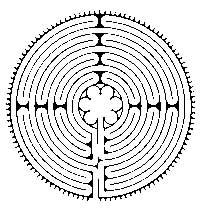
The Labyrinth at Chartres
It
seems likely that the master-builder saw the cathedral as an extension of Man
himself. The action of the ogive will of course continue within the man until
there is a real enhancement of consciousness.
There
must exist in man, M. Charpentier maintains, a means of knowledge on which
science has turned its back. Those who built the cathedral must have had access
to such knowledge. The crossed ogive, for instance, secret of the musical stone,
is constructed on the principle of the transformation of lateral into vertical
thrust and weight. Weight that creates thrust becomes its own negation. The
stone is in a state of tension which the master-builder can tune. We note that
whereas the well is 37 metres below the choir the vault is about 37 metres above
it. The length of the nave is in the relation of an octave with the length of
the choir; the width of the nave is in relation of an octave with the width of
the aisles. These proportions are also found in the elevation.
Line
and angle, height and width, the system of verticals and horizontals, reveal a
series of intervals, a musical scale, in accord with the five-pointed star.
There are in fact two architectures, M. Charpentier says, one in stone, the
other as it were a shaped emptiness which makes the sounding-box. Was it Walter
Pater who described the cathedral as frozen music?
Now
the author links his theme with the Crusades and a visit in 1118 of nine knights
templar to
What
indeed, if not the Ark of the Covenant and the Tables of the Law?
The
The
Commandments were not secret. M. Charpentier suggests that coming as the Tables
did from the hand of God they amounted to a contract and means of power. They
disclosed the cosmic equation so that to possess them would be to possess
dangerous secrets. It will be remembered that Moses promised the people power
and dominion through the Tables, which God wrote with his finger in a cypher
that could be construed in two ways, esoteric and exoteric. Moses was an
initiate of the Egyptian temple, which taught, with much else that is lost to
us, alchemical science. Certain units of measurement were also placed in the
Ark. Mr. Charpentier argues that as the
was
hidden in the temple, it was this the nine knights were sent to find. Solomon
planned the temple, which implies a knowledge of cosmic proportions and
standards of measurement. He also composed an erotic song, which became highly
recommended reading for white
Friars; a song in which it is written, with obvious reference to the
Traditions
regarding the
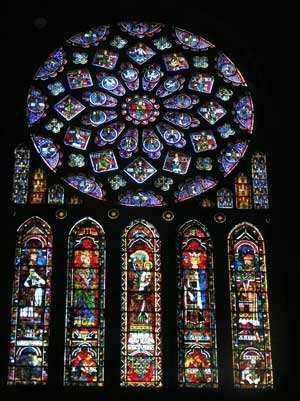
Stained Glass Windows of Chartres
Measure,
orientation and number, but not the dedicatory formula, are communicated to a
master-craftsman; and he, having worked out the harmonic proportions of the
fabric, draws the plan on the ground itself. The unity of the monument, the
effect it is to have on men, derive from the formula and to change them renders
the temple useless. The geometrical data that decide the plan of Chartres
Cathedral show that its harmonic development reaches completion at the towers,
which were built after the fire in 1134, well in front of an older church which
was then destroyed, as if in foresight of a church yet to come. In 1194 all but
the towers was again burnt down and the new cathedral was built almost in its
entirety between 1194 and 1220. The problems of how to contain the forces of
lateral expansion, of weight and other factors for the buttresses that must
take
the expanding thrusts within a space given by the formula, were solved. The
master-craftsman knew what he was about, had chosen his stone and had his labour-force
standing by. The work wasn't done by apprentices. The building of numerous
churches at that time was held up for want of money.
M.
Charpentier now discusses some important matters with mathematical and other
argument for which we simply haven't time.
The
germinal point of the cathedral, he writes, is the head of the telluric current,
where the altar once stood. Here sprang the column which is the first sign that
a temple is emerging, first relationship between the site and the sky. We then
have three Tables, round, square and rectangular, which have the same surface
and their number is 21, 2 and 1, that of Egyptian and Greek temples.
We
note that the square Table is constructed by taking the main axis of the
rectangular Table as its diagonal. The length of The Labyrinth at
It
is also the symbol of the Black Virgin. The master-craftsman took his essential
measurements from it all he had to do, when it came to squaring the circle, for
instance, was to use the drudical card of twelve knots or thirteen segments. Or
he may have followed the procedure used in the building of the pyramid.
But
what is the significance of the three Tables? Three Tables bore the Grail, it
has been said. They constitute a way of initiation. The Grail, our author says,
is an alchemical symbol and the word can't be dissociated from the word
Cauldron. Every Greek temple had its Crater or Cup. We are concerned, then, with
a vessel whose contents are beginning to partake of divinity,
to
be transmuted. Alchemy is the art of gathering and concentrating a vital current
and the concentration is called the Philosopher's Stone, whose powerful activity
allows the Adept to do what would otherwise take ages, to change base metal.
Actually or figuratively, into silver or gold. Transmutation through
concentration of the vital stream in themselves was what the pilgrims sought.
The
three Tables, then, represent three ways of approach, the round or intuitive,
the square or intellectual, the rectangular or mystical. The round Table
resembles a dance floor for dances which afford a means of integration with
natural rhythms, an approach from circumference to centre. Round dances led by
the bishop were customary in the cathedral at Easter. The square Table, a
squaring of the round, affords an initiation which is a passage of instinctive
ideas or impulses into consciousness. It is also a trap for an intellect which
may delude itself regarding the validity of its own creations, just as in the
game of chess Bishop and Castle are caught between their lines of movement. It
is often depicted by a chess-board and it is the child's game of hopscotch,
which proceeds from square to square. To square the circle is to transform
instinctive initiation into an initiation that is conscious and reasoned.
The
rectangular Table is a Table of revelation. There can be no intellectual
explanation of this. It is the Table of the Last Supper. Thus, the Tables
represent a sequence of three births.
Now
for the unforgettable windows. The power of the true Gothic stained-glass window
comes less from the colour of the mosaics than from a certain unanalysable
quality of both colour and glass. It doesn't react to light like ordinary glass,
but seems to turn into a precious stone that itself becomes luminous. No chemist
has so far penetrated the mystery. Luminosity and colour not caused by
iridsation brought about by the elements: none of these qualities are seen in
stained glass of the XIVth century. The windows, M. Charpentier says, are a
product of alchemy - anyone who has
seen them in their glory will be ready to believe it. The same thing appeared
towards the XIth century in the laboratories of certain Persian adepts, among
them Omar Khayam, poet of the rose; and there is evidence in documents deposited
by the nine knights with the Cistercians that this is the origin of the windows
at
Towards
1140 the source dried up, probably through the disappearance of some adept whose
work was done.
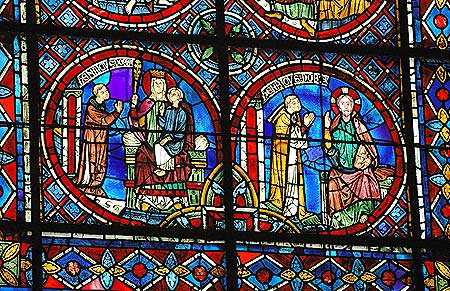
Intricate alchemic stained glass
Now
there is in light a particle of energy that is penetrating, sterilizing and
relatively dangerous to life. No alchemical experiment can be attempted in
daylight. The experiment in alchemy that is directed at the human being,
initiation, must take place in cavern or crypt. The Greek mysteries were enacted
at night. The alchemical windows acted as a filter to retain the particle that
is harmful to man's evolution within the
On
the question of funds, M. Charpentier argues that only the religious Orders
could play the part of banker-treasurer. The Order of the
There
were of course two other sources of wealth. First, alchemical gold, a
possibility that can't be rejected out of hand. Next, the Templars may have been
able to bring gold from the Mexican mines. But one way or another, M.
Charpentier maintains, the Templars were responsible for financing the project.
What, broadly, does it all come to? It was sought to create an instrument of
power, a crucible for the power of transformation. The cathedral is a means of
passage from one world to another. Certainly it isn't now wholly what it was,
the high altar moved from the place where it should be and other desecrations
effected through the stupidities of ecclesiastical rule. Today the tables are
crowded with chairs to facilitate the sleep of the right-thinking. But the
crucible hasn't lost all its power. Even today no man leaves the cathedral the
same as he went in.
Consider
the scene in old time. A man enters. The ogive raises him. He stands as he was
created, erect. He is in a world where the more stone weighs the lighter it is,
stone become spirit. He hears in himself the note of his own affinity with the
real. He proceeds by the route of the telluric current. He stands before the
round Table, called the labyrinth because of certain designs on the flagstones,
in which it is impossible to get lost because the only path leads to the centre.
He goes unshod that the feet may be in direct contact with stone that is an
accumulator for the properties of the current. Power works in him. The man who
reaches the centre, having danced, is changed when he advances to the square,
the intellectual Table where the Numbers expressed in the cathedral are
perceptible, where they can be rationalised under three great Roses. We note
that alchemically the rose stands for the action of fire and that only at the
square table is a simultaneous inflow from the three rose windows perceptible,
here
where the cathedral speaks to the mind. To pass to the mystical Table was to
renounce the world. Finally, we note that the Mound was inviolate. Was it, so to
say, taboo to prevent access to a place where some especially precious
subject
was hidden? Let us ask a question of our own: if the Ark of the Covenant was
hidden at
Towards
the end of the thirteenth century there seems to have been a withdrawal of
spirit from the western world. What was required of the Gothic mode has been
done. A Cistercian abbot led a crusade against the Albigenses. The Dominicans
invented the Inquisition. The Templars were put to trial. The Beauty sleeps once
more. But she will awake at the appointed time.
Originally
printed in LIGHT, a bi-annual journal published by the